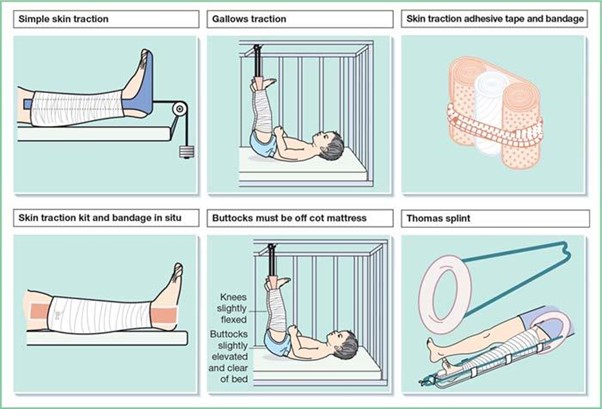Types of Skin Traction
Buck's Traction:
- Buck's traction is commonly used for lower extremity fractures, such as fractures of the femur, tibia, or fibula.
- The traction force is applied through a boot-like device placed on the lower leg, with the patient's knee in slight flexion.
- Adhesive straps or bandages are used to secure the traction to the leg, and weights are applied to the end of the bed to provide the pulling force.
Russell's Traction:
- Russell's traction is utilized for fractures of the femur or dislocated hips, where greater traction force is required.
- The patient's affected leg is placed in a sling-like device that extends from the hip to just above the ankle.
- Weights are attached to the traction apparatus, and the patient's hip and knee joints are maintained in a slightly flexed position.
Bryant's Traction:
- Bryant's traction is primarily used for pediatric patients with femur fractures.
- Both lower extremities are elevated and suspended off the bed, and traction is applied to both legs using adhesive strapping or bandages.
- The patient is positioned in a supine position, and weights are attached to the traction to provide the necessary force.
Pelvic Skin Traction:
- Pelvic skin traction is applied to stabilize and align fractures or dislocations involving the pelvis.
- Traction is exerted on the pelvis through pelvic belts or adhesive strapping, which are secured to the patient's body.
- This type of traction requires careful assessment and monitoring due to the proximity to vital structures and potential complications.
Cervical Skin Traction:
- Cervical skin traction is applied to the cervical spine to stabilize and reduce fractures or dislocations in this region.
- Traction is exerted through the use of a cervical collar or head halter that is secured around the patient's neck and attached to a weight system.
Upper Extremity Skin Traction:
- Skin traction can also be applied to fractures or dislocations involving the upper extremities, such as the humerus or radius/ulna.
- The affected arm is usually placed in a sling-like device or splint, and traction is applied through adhesive strapping or bandages with weights.
Modified Skin Traction:
- In some cases, healthcare providers may use a modified approach to skin traction based on the patient's unique condition and needs.
- This may involve adaptations to the type of traction device used or the amount of traction force applied.

Nursing Test Bank
Naxlex Comprehensive Predictor Exams
Questions on Types of Skin Traction
Correct Answer is C
Explanation
Correct Answer is B
Explanation
Correct Answer is D
Explanation
Correct Answer is B
Explanation
Correct Answer is D
Explanation
Correct Answer is C
Explanation
Correct Answer is C
Explanation
Correct Answer is B
Explanation
Correct Answer is A
Explanation
Correct Answer is B
Explanation
Correct Answer is A
Explanation
Correct Answer is B
Explanation
Correct Answer is C
Explanation
Correct Answer is A
Explanation
Correct Answer is B
Explanation
Correct Answer is B
Explanation
Correct Answer is C
Explanation
Correct Answer is C
Explanation
Correct Answer is D
Explanation
Correct Answer is B
Explanation
Correct Answer is A
Explanation
Correct Answer is B
Explanation
Correct Answer is D
Explanation
Correct Answer is C
Explanation
Search Here
Related Topics
More on Nursing
Free Nursing Study Materials
Access to all study guides and practice questions for nursing for free.
- Free Nursing Study Trials
- Free Nursing Video tutorials
- Free Nursing Practice Tests
- Free Exam and Study Modes
- Free Nursing Revision Quizlets
